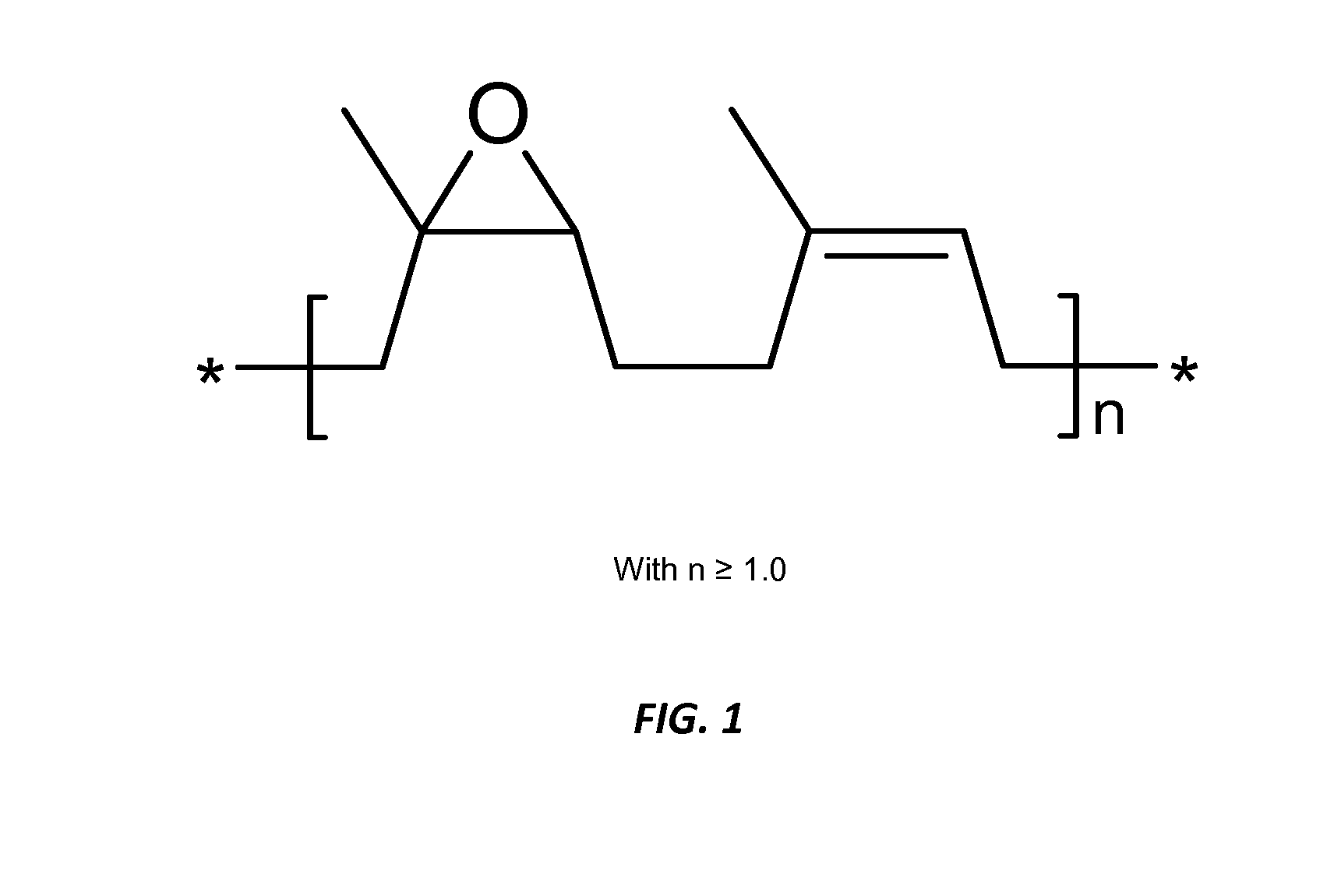Antistatic rubber compound and antistatic tire
a technology of antistatic rubber and rubber compound, which is applied in the direction of tire parts, rolling resistance optimization, transportation and packaging, etc., can solve the problems of electrostatic charge build-up on the surface of tires, interference with electronic circuits within vehicles such as radio or satellite navigation devices, and achieve the effect of reducing the rolling resistance of tires
- Summary
- Abstract
- Description
- Claims
- Application Information
AI Technical Summary
Benefits of technology
Problems solved by technology
Method used
Image
Examples
example 1
Formulations of Sulfur-Vulcanized Epoxidized Natural Rubber Based Compound for Commercial Vehicle's Antistatic Tire Tread Manufacturing Purpose
[0072]A sulfur-vulcanized epoxidized natural rubber based compound of this invention with various compositions of electrically conductive filler and white filler were produced in order to measure its physical properties and also electrical resistance. Selected examples of formulation for preparing the vulcanized epoxidized natural rubber based compound are shown in Table 1.
TABLE 1Formulations of Sulfur-Vulcanized Epoxidized Natural Rubber based CompoundPart per hundred rubber [p.p.h.r.]Raw material / BlendBlendBlendBlendBlendBlendBlendchemical1234567ENR 25100.0100.0100.0100.0100.0100.0100.0Carbon black-XC 7210.010.015.015.015.015.020.0Carbon black-N33045.035.020.015.05.00.00.0Silica-Zeosil 1165MP5.015.025.030.040.050.050.0Oil-Nytex 47005.05.05.05.05.05.05.0Antioxidant-Santoflex 6PPD1.01.01.01.01.01.01.0Antioxidant-Flectol TMQ1.01.01.01.01.01.01...
example 2
Preparation of a Sulfur-Vulcanization System Containing Epoxidized Natural Rubber Based Compound of Example 1 by Using a Combination of an Internal Mechanical Mixing Device and an Open Milling Device
[0081]At the first stage of mixing, epoxidized natural rubber based masterbatches with different proportions of electrical conductive filler and white filler (according to the formulation as shown in Table 1 of Example 1) were prepared by using an internal mechanical mixing device as illustrated by FIG. 2. A fill factor of 0.70 (from the total free volume of an internal mixing device's mixing chamber) was used to conduct the process. The starting temperature for each mixing was 70° C. and the rotor turning speed was 100 rpm. Each stage of the mixing process is described in Table 2:
TABLE 2Stages of Preparation of Epoxidized Natural Rubber basedMasterbatch by using the an Internal Mechanical Mixing Devicefor Steps (i) and (ii) and an Open Milling Device for Step (iii)Stage of mixingTiming1...
example 3
Epoxidized Natural Rubber Based Compound Prepared by a Sulfur-Vulcanization System Using an Open Milling Device
[0084]Epoxidized natural rubber based compound with different proportions of electrically conductive filler and white filler (accordingly to the formulation as shown in Table 1 of Example 1) were prepared directly by using a two-roll open milling device as illustrated in FIG. 3. The starting temperature for each batch was 30° C. Each stage of the mixing process is described in Table 3:
TABLE 3Stages of Preparation of Epoxidized Natural Rubber basedCompound by using the Open Milling DeviceStages of mixingTimingStage 1:1. Addition of epoxidized natural rubber 0th minute2. Addition of electrically conductive filler, 2nd minutewhite filler, processing oils, antioxidants,release agents and vulcanization activatorsto produce masterbatchStage 2:3. Addition of sulfur and vulcanization15th minuteaccelerators4. Discharge of blend20th minute(Total time =20 minutes)
[0085]Each of the sul...
PUM
| Property | Measurement | Unit |
|---|---|---|
| operating temperature | aaaaa | aaaaa |
| operating temperature | aaaaa | aaaaa |
| temperature | aaaaa | aaaaa |
Abstract
Description
Claims
Application Information
 Login to View More
Login to View More - R&D
- Intellectual Property
- Life Sciences
- Materials
- Tech Scout
- Unparalleled Data Quality
- Higher Quality Content
- 60% Fewer Hallucinations
Browse by: Latest US Patents, China's latest patents, Technical Efficacy Thesaurus, Application Domain, Technology Topic, Popular Technical Reports.
© 2025 PatSnap. All rights reserved.Legal|Privacy policy|Modern Slavery Act Transparency Statement|Sitemap|About US| Contact US: help@patsnap.com



